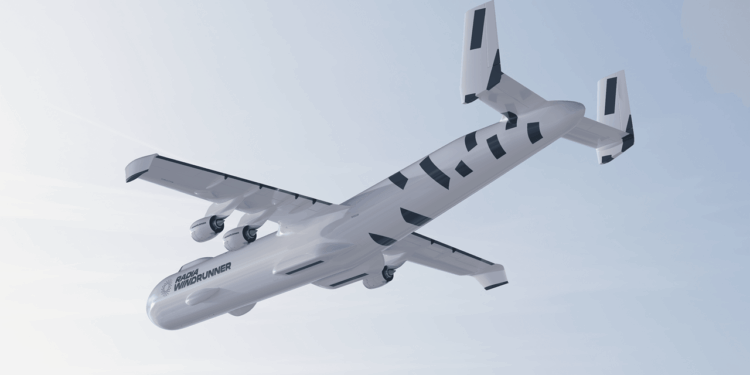Although the WindRunner is still in the developmental stage, Radia has aimed for the heavy lifter to make its maiden flight by the end of the decade.
Aerospace startup Radia announced at last week’s Air Force Association’s Air, Space & Cyber Conference that it would build a massive cargo aircraft that could be described as a flying aircraft carrier of sorts. The “WindRunner” would be an “ultra-large air cargo aircraft” meant to address the “oversized airlift gap.”
Instead of focusing solely on weight, the WindRunner would address the issue of volume—capable of carrying “mission-ready systems to austere or degraded locations,” the company explained, helping the Pentagon to meet its Agile Combat Employment (ACE) goals.
Many current heavy airlifters, including the C-5M Galaxy, C-17 Globemaster III, and A400 M Atlas, all share a similar flaw. Modern cargo aircraft typically run out of physical space in their cargo holds long before they reach their respective weight limits. This forces the disassembly of some large systems, requiring further logistical steps on either end.
“This inability to move fully assembled cargo can slow timelines, increase vulnerability, and complicate contested-environment logistics, especially across austere or infrastructure-limited environments where US and allied forces operate,” Radia warned.
The Radia WindRunner: Large and in Charge
The WindRunner would serve as a much larger Roll-on/Roll-off Ready heavy lifter, which the company claims could offer seven times the volume of the C-5 Galaxy and as much as 12 times the volume of the C-17 Globemaster III.
The company suggested that one WindRunner could carry upwards of six CH-47 Chinooks, or even four CV-22 Ospreys, without the need for either rotorcraft to be disassembled for transport. As envisioned, the WindRunner could also hold four F-16s or four F-35Cs, the carrier-based version of the Joint Strike Fighter.
In that way, the WindRunner would be akin to a flying aircraft carrier—albeit not capable of actually launching aircraft while in flight. Still, it could transport those aircraft to distant bases without the need for refueling en route, while also cutting down on the time those fighters would need to spend in the air to reach a different part of the world.
The WindRunner Could Simplify the Air Force’s Logistics
Radia further suggested the WindRunner would be a force multiplier, able to carry upwards of a dozen Apache helicopters, compared to the two that the C-17 can transport. That could reduce movement time from days to hours. In addition, the aerospace firm touted that the heavy lifter could operate from short runways of 1,800 meters or less, and that no specialized loaders or bespoke facilities would be required to unload from the aircraft.
“Strategic mobility buys time and space for the force,” explained Mark Lundstrom, founder & CEO of Radia.
“WindRunner was designed to move full systems, such as long-range radars, tiltrotors, CCAs, mobile hospitals, and other complex, oversized assets, without disassembly, without special infrastructure, and without slowing operations,” Lundstrom added. “We’re not replacing the legends that have carried the load for decades; we’re reinforcing them with a commercially fielded capability that can surge when and where commanders need it, for ministries of defense worldwide.”
Although the WindRunner is still in the developmental stage, Radia has aimed for the heavy lifter to make its maiden flight by the end of the decade. Beyond direct military applications, the aerospace startup also highlighted how it could be employed in rapid humanitarian and disaster response.
About the Author: Peter Suciu
Peter Suciu has contributed over 3,200 published pieces to more than four dozen magazines and websites over a 30-year career in journalism. He regularly writes about military hardware, firearms history, cybersecurity, politics, and international affairs. Peter is also a contributing writer for Forbes and Clearance Jobs. He is based in Michigan. You can follow him on Twitter: @PeterSuciu. You can email the author: [email protected].
Image courtesy of Radia.


















